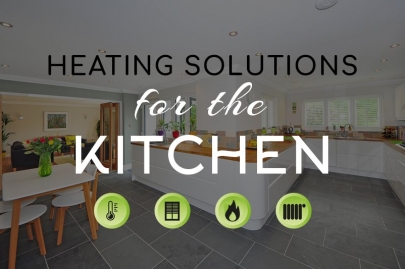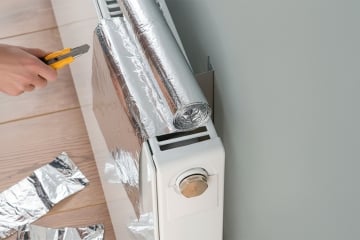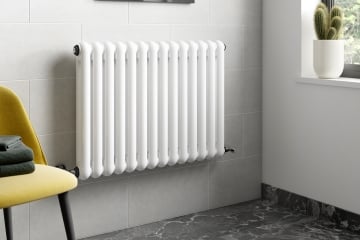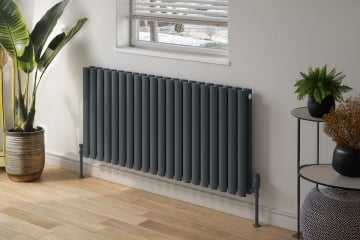Heating Solutions for the Kitchen

Heating Solutions for the Kitchen
In many modern homes, kitchens act as lifestyle hubs. We cook, clean and often eat breakfast and other meals in them. It isn't rare to spend at least an hour of our days in the kitchen, yet they are often one of the coldest rooms in a home. There are a few possible reasons for this: some people don't anticipate spending as much time in their kitchen as they eventually do, so they don't invest in proper heating, and some move to a property without kitchen heating and don't want the extra effort and cost of installing it. In many cases, however, homeowners simply struggle to find the space to add heating to their kitchen. Due to the amount of storage units, work surfaces and cooking or cleaning appliances in a kitchen, there is often very little wall space for mounting traditional radiators.
Fortunately, there are now more methods than ever before to keep your kitchen warm.
Radiators
You probably don't need telling that radiators can be used to keep your kitchen warm; the problem is usually finding somewhere to place them. Luckily, there are now many options that will allow you to fit radiators into whichever narrow spaces you can find, with more shapes and sizes than ever before. The variety of different styles and finishes in modern radiators means it's now easy to find a unit that is in tune with the rest of your kitchen design and colour scheme. Even tight spaces can house small modern radiators that are as effective at heating your kitchen as their older, larger counterparts. With countless vertical and horizontal radiators available today, you're almost guaranteed to find a radiator that will fit even the smallest areas.
In the event that you do have a larger kitchen with plenty of wall space, you can obviously disregard much of this advice and buy as large and opulent a radiator as you like. In this case, you can choose whichever designer radiator you want but it might still be worth considering options other than a mounted radiator, especially if you're aiming for a minimalist look. The benefits of a kitchen radiator are numerous: due to the massive variety in styles and sizes, it's possible to find a unit with the perfect heat output for your room, meaning your kitchen will be efficiently heated without wasting money on unnecessarily high bills.
Underfloor Heating
A great way of avoiding the need for wall space entirely, underfloor heating is instead placed beneath your kitchen floor. Usually formed by a series of pipes that channel hot water, much like a traditional central heating radiator, this heat is then conducted by the floor tiles, raising the temperature of the floor and the rest of the room. In addition to water based underfloor heating, there are now many electric versions that can provide inexpensive kitchen heating when combined with renewable energy such as solar panels. Underfloor heating is usually more expensive than a traditional radiator, with much of this cost being due to the amount of building work involved in installing it. As you'll need to remove your current kitchen floor surface, underfloor heating is best installed as part of a wider kitchen renovation project. You'll also need to ensure that the surface of your kitchen floor is suitable, as tiles or floorboards that are too thick or made with a material with poor heat conductivity will greatly reduce the effectiveness of your underfloor heating.
The larger the room, the more underfloor heating you'll need to install and the greater the cost, but the comfortable warmth of your room (and floor, if you prefer walking around with bare feet) makes underfloor heating a great choice. Before installing underfloor heating, it's important to check how effective the surrounding surfaces are for heat insulation; you don't want to spend money on new heating only for it to be largely wasted. Underfloor heating is a luxurious option that helps keep your kitchen space clear of radiators but the cost and potentially extensive installation work mean it isn't a choice for everyone. If you're already performing a major renovation on your kitchen, however, it's well worth considering. You can read about the surprising origins of underfloor heating elsewhere on our blog.
Central Heating Cookers
There are a number of cookers that will heat your kitchen, as well as providing hot water to your central heating system. These cookers, such as the Rayburn catalogue and the “Thermo” from La Nordica, combine the ability to cook with the functions of a boiler, generating a great deal of heat. This heat is created by burning fuel, usually wood or kerosene depending on the model, and then largely retained within the unit. When it's time to cook, the hot plates and ovens are immediately ready to be used and offer a consistent heat that gives better tasting results than the directed heat of many modern cookers. At the same time, they constantly heat your kitchen, keeping it comfortably warm, and provide hot water to your central heating system. Historically, there has been some discussion regarding how sensible a choice these cookers (and other heat generating cookers such as AGAs) are, due to their constant fuel consumption. More recent models have addressed these concerns, thanks to modern technology, with certain models now allowing owners to program their schedule the same way as any modern heating system. A central heating cooker is a solution for not only your kitchen but also for the rest of your home.
Replacing Windows
While not exactly a heating solution, ensuring your kitchen is properly insulated is another important step in keeping it warm. There's little point in installing new radiators or underfloor heating, only for the temperature to drop because of draughts and warm air escaping outside. If you live in a relatively new property, you'll almost certainly already have double glazing already. If you only have single glazing, it's well worth the investment for windows that will reduce both heat loss and condensation. New windows alone won't make your kitchen warm but they will ensure that your other heating solutions work as effectively as possible and will help you save money in the long term thanks to lower energy expenditure.
Consider Layout
Whichever heating option you decide on, it's worth taking some time to consider the overall layout of your kitchen. Again, if you already have your units and appliances installed it can be hard to make major alterations, and radiator placement will usually be dictated by simply finding any clear wall space. Even so, it's possible to place your radiator beneath a breakfast bar, keeping your kitchen warm without sacrificing surface space. Placing your radiator and refrigerator or freezer in close proximity to each other is also a bad idea, as they each have the opposite effect and will cancel out much of what each unit is trying to achieve. Keep these concerns in mind while designing your kitchen.
If you do decide on some new heating units for your kitchen, We offer a huge range of radiator styles and a number of electrical underfloor heating panels at amazingly low prices.
Related Posts
Radiator reflectors promise to boost your heating efficiency and reduce energy bills by reflecting heat back into the room instead of letting it escape through the wall. Sounds brilliant, but do they actually deliver?
Getting radiator placement wrong doesn't just look odd - it genuinely wastes energy, reduces comfort, and can cost you money every winter through inefficient heating. So what’s the best place for them?
Ever wondered why radiators seem to always end up under windows? Does seem odd, doesn’t it? Why put your heat source right next to the coldest part of the room?




